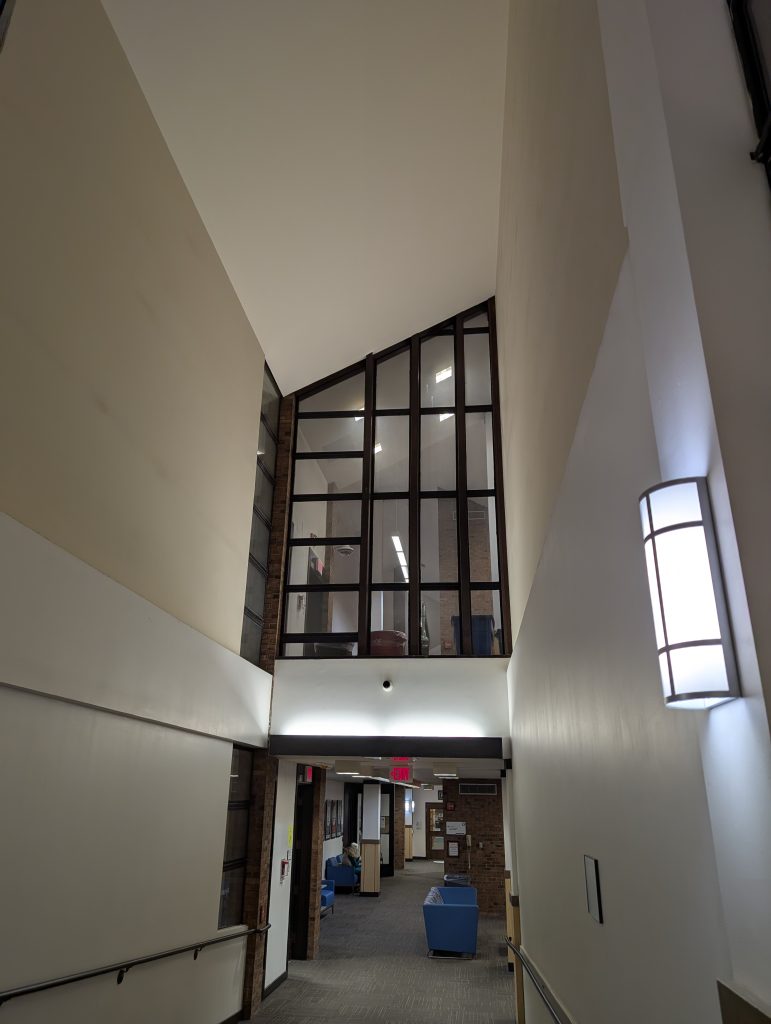I can describe these weeks as frustrating, exhilarating and tiring.
The first three weeks of the semester have felt super-busy, but we’re off!

First, the frustration. The main frustrations I have had surround one of my college’s practices and some student issues. As I wrote last semester, my college allows students to register up to a week after classes have started. Students and I have gotten to know each other, have learned about class and have started on the activities for the first paper, and a new student can join us after that.
Before classes started, I was at near max capacity for my 4 composition classes, which is 20 students each. I prefer to be at capacity so all the students are part of the beginning-of-the-semester activities listed above. I had 1 class that had 18 or 19 students, so 1-2 students registered late.
If dealing with late-registering students was the only issue and if other students were all in class from day 1, that’d truly be easy to handle. Unfortunately, some students who registered on time missed for other reasons—like illness or weather. Juggling the knowledge of who has missed class and who has registered late and what each needs is a challenge. Since my college has enacted the policy where students can register late, it’s all par for the course.

The new situation I dealt with this semester is that I had a few students who were dropped during the first week of class for non-payment. I don’t know if their financial aid was late or if they were responsible for an unpaid bill. Either way, they were dropped by the college and new students registered in their place. So even though I was at capacity, having a student drop means I had a spot open and another student registered. There was more of a chance for late enrollees.
Well, 1 student who was withdrawn stopped by the classroom and asked what she needed to do after her financial aid was figured out. I could have said that she’d have to find another class or even take it in the future, but she had already connected with our class. I asked my Dean to give her an override to stay in class. My Dean agreed and I was happy about that. I just had wished the other student hadn’t been able to slide in and take that spot because now I was over-capacity, which isn’t a huge deal, but because of either the students’ issue of nonpayment or the college’s issue of when students were dropped (they should have been dropped before the semester so they couldn’t even start classes without payment), I had another new student.
By this time, I had started my classes and got them going, I had communicated with students who were not in class due to them being able to start late, due to illness, due to transportation issues due to cold, snowy weather, and I had worked on keeping a student in class because I had already connected with her.
I had one more student situation I handled. I had another situation where a student was dropped because of nonpayment. He came to class, told me about the situation right away, went down to our financial aid office and was able to get back into the class if I allowed it. This is a student from a US state that has a very, very poor reputation in education. I found with the little writing we had done so far that he was a really strong writer. I wanted to keep him, so I again asked my Dean to reinstate him. Just like the female student I discussed earlier, this student was one I wanted to keep and it was my choice to work to keep him in class. For this one situation, I dealt with a bunch of emails. I emailed the student because I wanted to keep him, I got an email from financial aid telling me what happened, the student replied a little later. Again, this situation didn’t need to happen if the college had communicated with the student before the semester began, or if financial aid had gone through properly.
I’ve dealt with a third situation where I put in extra work to support a student was fruitless. My college has an apprenticeship program where students work at a manufacturing or service facility. I’ve had some great students in my online classes because of this, so when one student hadn’t started doing any work for the first week even though I had emailed multiple times, I was unsure about what I wanted to do. Part of me wanted to withdraw him right away. In an overloaded schedule, one less student is a good thing.
Since the administrator for the program had let me know I had apprentices in class, I went ahead and emailed the administrator. She hounded him down. She asked me a bit later to see if he had logged in and started his work. Nope, he hadn’t. I again decided that I’d wait to the end of week 2 and if he didn’t log in, I’d withdraw him. I emailed him and the administrator to let them know.
When he finally got into class and did 1 assignment, I let the admin know. I never had received anything from him letting me know why he hadn’t been in class, etc. I let the next week ride out and he turned in one more assignment and then nothing. I withdrew him and notified the administrator. This week, the administrator asked me for my syllabus so she could show the policy to the student and his boss. I thought to myself, “This student has taken no responsibility for his work, no responsibility for withdrawing from class, and now I have to provide the syllabus so that the administrator could explain to him and his boss why he can’t pass class? It sounds to me like women are doing this students’ job for him. He no longer had access to my class, though, so I went ahead and sent the syllabus. Alright, 1 less student to deal with.

During the beginning of week 3, I opened my email and I see I forgot to do the census rosters—I forgot to show the college who is attending and who is not. I think this is because I drop students as soon as I know they are not going to remain in class. It helps me make sure I know who is in my class and who isn’t—this is more work for me, and it helps me. So there are some processes that the college has that I have taken care of in a different way, but I still have to do the work the college wants. If I had more trust in the college, I would likely not withdraw anyone until census day, but with students being able to join class a week late for the first time, for students to have been withdrawn for nonpayment during the first week of class and for instructors to need to decide whether or not to reinstate them, it’s a lot. Of course this is all on top of trying to get 5 classes worth of students started on the material and connecting, etc.
Another way to think about this is that the college and I don’t always work in the same ways and though they can skip doing things I may want/need ( like notifying me when students add or drop within the first 2 weeks), I cannot not do the work the college needs—such as the census roster that I forgot to do for a week. My dean got notification of that, so now she’s been pulled into my mistake.
Then, that student who is in the apprenticeship program . . . well the administrator asked if I had just withdrawn him as a late census drop meaning that he wouldn’t have to pay for the class and wouldn’t get an F or a W (for withdrawal) form class. I said that no. He was a regular drop. He or his employer should have to pay for the class. He wasn’t withdrawn until week 4, not week 2. I don’t know what the administrator is going to do now, but at the time she said the class was wiped from his account. I think this means no one has to pay, so I worked for 3 weeks dealing with the communication and the students’ only consequence is that he has to take the class another time. The college’s consequence is a loss of money and time for how many employees worked together for this situation. But, let me share some of the good stuff . . .
Exhilarating—for me there is a magic in teaching. When there’s a flow to the discussion or when I see students connecting with each other, I am just excited by this. This past week, my classes were doing what I call Creating Class Practices. The first week of class, I ask students to write about how they want to feel during class. I group those responses into similar topics. Ex: a handful of students said they wanted to feel comfortable, so I put that as a category. Other students say they want to not be bored or that they want to be interested in class. Still others mention wanting to feel confident that they are learning. I group these responses into 5 different groups. Then, I put the responses into a chart where students fill out 3 columns. They first use the “feelings cards” I made for them to make sure we understand what actual feelings people want to have. For example, if someone says I want to feel like I am always welcome in class, we may use the feeling card “content.” One reason we do this is that a lot of times we use feeling words for non-feelings. I feel like going on a bike ride. Um, that’s not a feeling in NVC; it’s a strategy. I may feel excited when thinking of biking. I may feel nervous and thus I want to get some energy out by biking. Those are feeling words in NVC.

The next column is “needs.” I ask students to look at the original statements and the feeling words to try to figure out what the person is saying they are needing. If students want to feel comfortable while talking, maybe they have a need for acceptance or connection. Maybe their need is to be clear on the material.
From there, we develop strategies for fulfilling the needs. We could have skipped all these steps and just answered the question, what do we want to do to have a good class this semester? We may even come up with the same strategies such as carefully listening to others or speaking our minds or doing our homework so that we are ready for class, but creating strategies from needs is super-important for me. We actually have solid reasons for trying to achieve what we want. Eventually, we can see whether the strategies are fulfilling our needs or not. If not, we can use a different strategy.
This past week, then, we worked on class practices. One of my students—a trans man said something about how he struggles when he is expected to be tolerant of others’ views when those views are directly intolerant of him. If you’re trans and people are discussing why it’s wrong or disgusting to be trans, how can this student feel safe? Our class had created strategies that seemed contradictory and touched on the issue of what is acceptable to say in class and what isn’t. On one side, students want to be open-minded and want others to be so. On the other hand, students want to feel safe and we can more deeply learn if we feel safe. On the first hand again, I want people to be able to say and explore what they want—how can someone learn how damaging it is to make a racist comment, for example, unless they do it? In a classroom, there’s a balance of trying to keep students safe and trying to allow people to make mistakes.
In short, we talked about this as a class and things got heated. I asked every group to rewrite some of the practices to clearly state what they want. I haven’t looked at the revisions of the statements yet, but students seemed to understand the dilemma, so I am excited to see what they created.

While talking about tolerance, one student wanted to make sure no one said anything that is not true—specifically relating to issues going on in our world today. She’s liberal, so many things that conservative people would say –stuff Trump says—she’d say we can’t say it or at least that she should challenge it. I totally agree that she should challenge it and make sure we learn to figure out what is true and what is not. Unfortunately, we don’t have time to research every topic before we speak. I am a little worried that she’s asking for the impossible. However, I am in a different space as being the teacher. I get delight from hearing students work out thoughts as they speak them. I do get discouraged or confused about how to handle certain situations when they come up—when a particularly conservative statement stands or doesn’t get challenged to the degree I’d like, but I may be more accepting than seems acceptable to others. We are facing huge consequences for inaccuracies in the world today—and the inauguration of our next president happening just a week ago.
Before I start worrying, the situation is exhilarating. Lots of students spoke and shared and learned from each other—and to me, that’s where the magic or flow comes in. I guess it fulfills my need for contributing to their learning and my need to learn and grow as well.

Tiring. I think that the combination of the frustrating and exhilarating week is what made it tiring. I am tired physically and emotionally. Those first weeks, I slept a lot, worked a lot and ate a lot.
As I move towards the end of the semester when I will leave my college, I am hoping I can find ways to work with students so I can be a part of the magic that learning is without having to deal with as many of the forces that make what can be natural and easy, an uphill battle.
Peace Out (and In),
Julie
Photos are from a college I worked at for just a semester. I love how there are nooks and crannies throughout the buildings. There’s real wood and brick indoors as well. To me, it feels much more like a college than where I currently work which is more business-like.

4 COMMENTS
Margo
5 months agoThank you for this, Julie. I appreciate your description of all of the invisible administrative work teachers have to do, and keep thinking how hard could it be for administrators to come up with a clear efficient policy/procedure that would eliminate all of the bs you have to go through?! But then, I’ve never been an administrator at that level, so I’m guessing it’s harder than I am imagining…..
The way you frame your class discussions (in NVC terms) and the actual class discussions are so rich. I love that students are discussing things in this way, and I feel sure that they are truly learning in ways that will make a difference in their lives and in the societies around them. Heat in a discussion is a sign that folks are engaging, and learning how to engage productively in a heated discussion is a fantastic skill to learn, in and of itself! And then thinking about understanding and accepting folks who are different from oneself – well that is pure gold, especially in today’s world.
As always Julie, your work and thinking are inspiring, and I appreciate your taking the time to share them.
Julie
5 months ago AUTHORThank you, Margo!
I don’t know how difficult it would be for admin to create clear, efficient policies for the issues I mention. I believe that if the college’s priorities are students and learning, I think it’s possible. Heck, it might be fun coming up with solutions! With a bunch of different people needing and wanting different information and with priorities ranging from money to reputation and growth, it may be more difficult.
I appreciate your thoughts on how I teach. I see so much potential and at times I see positive things happening in class. I know what I am doing and I know why I am doing it–there are just so many roadblocks at times.
Thanks for reading. This was a long blog post.
Deb
5 months agoEnjoyed reading about how you use NVC in your class.
Julie
5 months ago AUTHORThanks, Deb!